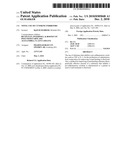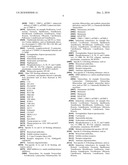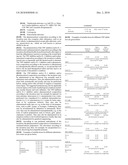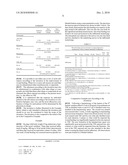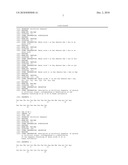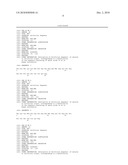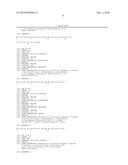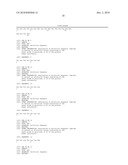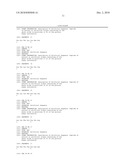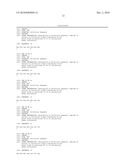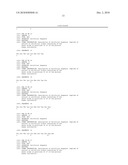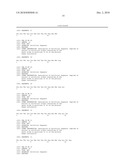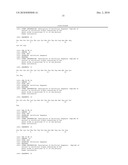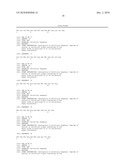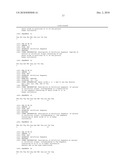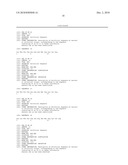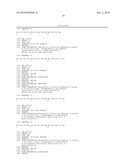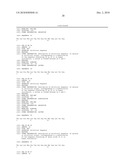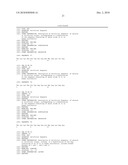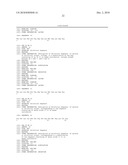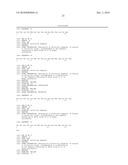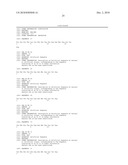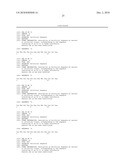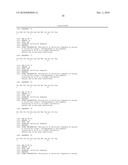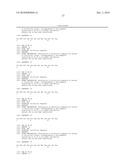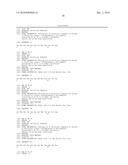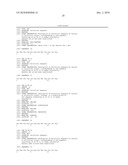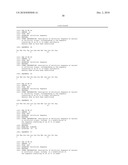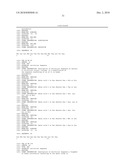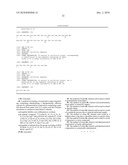Patent application title: NOVEL USE OF CYTOKINE INHIBITORS
Inventors:
Kjell Olmarker (Molndal, SE)
Assignees:
PHARMASURGICS IN SWEDEN AB
IPC8 Class: AA61K3840FI
USPC Class:
514 209
Class name: Designated organic active ingredient containing (doai) peptide (e.g., protein, etc.) containing doai glycopeptide utilizing
Publication date: 2010-12-02
Patent application number: 20100305048
Claims:
1-45. (canceled)
46. A method for treating a wound and/or improving healing comprising administering a therapeutically effective amount of a pharmaceutical composition comprising a peptide derived from amino acid 12 to amino acid 40 of human lactoferrin to a patient in need thereof, wherein:said peptide inhibits a pro-inflammatory cytokine;said peptide comprises 20Cys-Phe-X1-X-.sub.2-X3-X4-X5-X6-X7-L- ys-Val-Arg31 (SEQ ID NO: 99), wherein X1 is Gln or Ala; X2 is Trp or Leu; X3 is Gln, Lys, Orn, Ala, or Nle; X4 is Arg, Lys, or Ala; X5 is Asn, Orn, Ala, or Nle; X6 is Met or Leu; and X7 is Arg or Lys; andsaid peptide is selected from the group consisting of SEQ ID NOS: 2-5, 8, 31-37, 47, 49, 51, 63, 65, 67, 70, 72-74, 80-83, and 87-97.
47-48. (canceled)
49. The method of claim 46, wherein said wound is related to posttraumatic tissue injury.
50. The method of claim 49, wherein said posttraumatic tissue injury is caused by surgery.
51. The method of claim 46, wherein said wound is related to thermic injury.
52. The method of claim 46, wherein said wound is a result of a metabolic process due to reduced nutritional supply.
53. The method of claim 52, wherein said wound is a diabetic ulcer, a leg ulcer, a decubitus ulcer or a gastric ulcer.
54. The method of claim 46, wherein said wound is a result of exposure to a toxic compound.
55. The method of claim 46, wherein said pharmaceutical composition is locally administered.
56. The method of claim 46, wherein said pharmaceutical composition is systemically administered.
Description:
FIELD OF THE INVENTION
[0001]The present invention relates to pharmaceutical compositions and methods for improving wound healing.
BACKGROUND OF THE INVENTION
[0002]Wound healing is a positive physiological reaction that may restore anatomy and function of various tissues after trauma. The trauma may be accidental, the result of surgical intervention or the effect of a disease or genetic condition. The ideal end result of wound healing should be to restore the tissues to the situation before the trauma. Wound healing may be delayed or incomplete due to various independent factors. This may lead to chronic conditions with impaired restoration and function of the injured tissue. Many factors delaying the wound healing may be inhibited by specific treatment. For instance, infections may be treated by antibiotics, reduced blood flow may be treated by compression bandages and oxygen therapy and seromas may be evacuated by drainage. One additional way to facilitate wound healing would be to reduce the scar formation. In all cases of wound healing, however, it would be desirable to enhance the inborn properties of tissues to heal by interfering with the wound healing process per se. A method for controlling and improving wound healing would be of a great value in most cases of posttraumatic or post surgical wound healing.
SUMMARY OF THE INVENTION
[0003]Based on the knowledge derived from the literature the inventor assessed the efficacy of improving wound healing by administration of TNF in a laminectomy model on the rat (see the Comparative Example below). To his surprise, he found, contrary to what could be expected, that the wound healing was significantly impaired in the rats exposed to TNF.
[0004]Since administration of TNF increased scar formation and also negatively influenced the wound healing per se, the inventor realized that the in vitro data acquired in experimental settings regarding fibroblast regulation are not applicable in vivo, and that these findings had to be re-evaluated in light of the in vivo situation.
[0005]The cytokine network is complex and what may seem to be evident from an in vitro setting may often prove not to be applicable in the in vivo set-ting. The in vivo situation at the area of wound healing comprises a vast number of known and unknown substances that may interact in ways not present in vitro. Administration of a cytokine in one concentration may have an effect that is counteracted by administration of the same cytokine in a higher dose due to synergistic inhibition and stimulation between the various cytokines as well as physiological inhibition of its release from adjacent cells.
[0006]It is generally assumed that the inflammatory reaction seen in tissues undergoing wound healing is a positive event that is necessary for normal wound healing to occur. However, the inventor assumed that this might be a misleading conclusion based on the findings of the comparative example (see below). Various biological substances regulate the activity of specific cells during physiological processes. This may be assumed to be true also regarding wound healing. One component of normal wound healing is the regeneration of injured cells at the site of wound healing. Regeneration is usually promoted by various growth factors. Under certain circumstances, pro-inflammatory cytokines may counteract the effects elicited by the growth factor in a way that there is a balance between stimulation (growth factors) and inhibition (pro-inflammatory cytokines). The inventor assumed that this might be the case also at wound healing. A feasible way to shift the balance of stimulation and inhibition by pharmacological means would be to either enhance the level of stimulation or to reduce the inhibition. Since the comparative example (see below) clearly indicated that administration of TNF reduced the wound healing the author assumed that inhibition of the same or other substances with similar action instead might improve wound healing.
[0007]In the literature it is has been recognized that fetal tissues heal with emphasis of regeneration of the injured tissue with no or little scar formation. In contrast, adult tissues instead may result in scar formation that may dominate over tissue regeneration. Since the inflammatory reaction in fetal tissues during wound healing is less pronounced than during adult wound healing one might assume that reduction of the inflammation per se might be beneficial for the wound healing.
[0008]The inflammation at the site of wound healing induces an increased blood flow in the wound healing area. The inflammation also induces an activation of adhesion molecules that, together with a simultaneous increase in vascular permeability, may facilitate the migration of inflammatory cells to the wound healing site. Inflammatory mediators also have leucotactic or chemotactic properties, i.e. attract white blood cells to the area of wound healing. Two important inflammatory mediators responsible for this leucotaxis are TNF and IL-1. TNF and IL-1 synergistically with other chemokines stimulate this local inflammatory response. Since the main contribution of inflammatory cytokines to the site of wound healing is delivered by invading leucocytes it would be useful to limit the number of leucocytes by inhibiting the migration of these cells. Since pro-inflammatory substances are mainly responsible for the migration of the leucocytes to the wound healing site this should be achieved by inhibiting the activity of such substances.
[0009]The inventor therefore assumed that a more feasible way to improve would healing than previously suggested was to reduce the activity of pro-inflammatory substances, which he also later found to be true. This both pre-vents cell migration to the site of wound healing and may shift the balance of stimulation and inhibition of tissue regeneration in favor of stimulation. Since TNF and IL-1 are responsible for both these mechanisms, the most efficient way to improve wound healing is to inhibit the action of these two pro-inflammatory cytokines or other pro-inflammatory cytokines. This was also confirmed in the example displayed below.
[0010]The characterizing features of the invention will be evident from the following description and the appended claims.
DETAILED DESCRIPTION OF THE INVENTION
[0011]As discussed above, and further demonstrated in the Example below wherein administration of infliximab to pigs with a standardized laminectomy is discussed, the inventor found, contrary to what could be expected from existing literature, that inhibition of pro-inflammatory cytokines is an efficient way to control wound healing. Such pro-inflammatory cytokines are tumor necrosis factor (TNF), interleukin 1 (IL-1), interleukin 6 (IL-6), interleukin 8 (IL-8), interleukin 12 (IL-12), interleukin 15 (IL-15), interleukin 17 (IL-17), inter-leukin 18 (IL-1), granulocytes-macrophage colony stimulating factor (GM-CSF), macrophage colony stimulating factor (M-CSF), monocyte chemotactic protein-1 (MCP-1), macrophage inflammatory protein 1 (MIP-1), RANTES (regulated upon activation, normal T-cell expressed, and presumably secreted), epithelial cell-derived neutrophil attractant-78 (ENA-78), oncostatin-M (OSM), fibroblast growth factor (FGF), platelet derived growth factor (PDGF), and vascular endothelial growth factor (VEGF); and in particular TNF (also called TNF-α) and IL-1 (including both IL-1 α and IL-1 β).
[0012]The suggested treatment is applicable at all kinds of surgery. It may also be used after traumatic tissue injury. Tissue injury may also be the result of toxic influence, as the result of reduced blood flow due to vascular disease, or as the result of a thermic injury, and the treatment according to the invention is applicable also for these three latter conditions.
[0013]For the purpose of this disclosure, the terms "blocking agent", "blocking substance", "inhibitor" and "antagonist" may be used interchangeably.
[0014]As stated above, inhibition of a pro-inflammatory cytokine is useful for improving wound healing. This inhibition is possible to achieve by any suitable cytokine inhibitor, such as available pharmacological compositions.
[0015]Persons skilled in the art are well aware of what is intended by a pro-inflammatory cytokine. For the purpose of this disclosure, it may, however, be further clarified that the expression "a pro-inflammatory cytokine" relates to any substance from the cytokine family that posses one or more of the following specific mechanisms of action: 1) increasing vascular permeability, 2) attracting white blood cells (leucotaxia or chemotaxia), 3) activating macro-phages, and 4) recruiting macrophages to the site of wound healing. These effects may be assessed for each individual substance by use of the assays disclosed below. "A substance that inhibits a pro-inflammatory cytokine" as it is used herein thus relates to a substance that may block one or more of the four listed effects in the assays disclosed below. However, due to differences between species, one may also translate findings from the experimental setting to the human situation. For instance, if a monoclonal antibody with specificity towards a specific cytokine of a certain species inhibits the action of the cytokine in one of the three ways disclosed below in that specific species, one may assume that a monoclonal antibody, with specificity towards the human version of the cytokine, may inhibit this cytokine in the human situation.
[0016]1) Assay for increase of vascular permeability: A golden hamster, weighing 65-100 g, is anaesthetized with a mixture of Apozepam® (Diazepam 5 mg/ml Apothekarnes Laboratorium, Oslo, Norway) and Mebumal Vet® (Penthobarbital 60 mg/ml, NordVacc Vaccin AB, Malmo, Sweden) volume ratio 10:1. An initial dose of 0.3 ml is given intraperitoneally. Additional injections of 0.1-0.4 ml are administered each 30 minutes. The hamster is placed on a heated (37° C.) perspex plate, and the right cheek-pouch is everted over a translucent rubber plate and covered with plastic film in order to prevent reduction in blood flow rate due to direct exchange of oxygen. An injection of 0.3 ml of FITC-Dextran (mw 150.000, 25 mg/ml, Sigma, St Louis, USA) is made in the femoral vein for fluorescence vital microscopic observations of macro-molecular extravascular leakage. Temperature and humidity is controlled by irrigation of saline at 37° C. An injection of approximately 0.02 ml of a suitable concentration of the substance to be tested is made between the two layers of the cheek-pouch using a thin injection needle (diameter 0.4 mm). The same volume of saline is performed in an adjacent part of the cheek-pouch at a distance from the other injection site sufficient to eliminate the risk of communication between the saline and the tested substance within the cheek-pouch. The injection procedures are carried out under a stereomicroscope to minimize mechanical damage to the microvessels. Microvascular reactions are studied for 60 minutes at various magnifications, using fluorescence microscopic techniques (Leitz, Wetzlar, Germany). A pro-inflammatory cytokine as defined according to the present invention induces a leakage of the fluorescent macro-molecule FITC-dextran. A similar leakage should not be observed at the site injected by saline.
[0017]2) Assay for leucotaxia or chemotaxia: A pig, bodyweight 25-30 kg, is anaesthetized with an intramuscular injection of 20 mg/kg bodyweight of Ketalar® (ketamine 50 mg/ml, Parke-Davis, Morris Plains, N.J.) and an intravenous injection of 4 mg/kg bodyweight of Hypnodil® (methomidate chloride 50 mg/ml, AB Leo, Helsingborg, Sweden) and 0.1 mg/kg bodyweight of Stresnil® (azaperon 2 mg/ml, Janssen Pharmaceutica, Beerse, Belgium). Anesthesia is maintained by additional intravenous injections of 2 mg/kg body-weight of Hypnodil® and 0.05 mg/kg bodyweight of Stresnil®. One ml of a fluid containing a sufficient concentration of the substance to be tested is placed, in a suitable concentration locally in its natural form, in slow-release preparations or by continuous administration by osmotic mini-pumps, in a specially designed titanium-chamber. The chamber is 5 mm high and has a diameter of 15 mm. The top could be dismounted and is perforated with 18 holes, each with a diameter of 1.4 mm. The chamber, together with one chamber with the same volume of saline, is placed subcutaneously in the lumbar region through separate incisions, with no communication between the chambers. After 7 days the pig is reanaesthetized similar to the first procedure. The chambers are harvested and the content of the chamber is placed in a test-tube together with 1 ml of Hanks' Balanced Salt Solution (Life Technologies, Paisley, Scotland). From this suspension, 100 μl is used to wash out the chamber for remaining cells. This procedure is repeated 5 times. The test-tube is then shaken for 15 seconds. A total of 25 μl of the suspension and 25 μl of Turk's staining medium (Sigma, St Louis, USA) are mixed and placed in a chamber of Bucker. The total number of leukocytes in each chamber is determined using light microscopy. The chamber with a pro-inflammatory cytokine as defined according to the present invention then contains significantly more white blood cells than the chamber with only saline.
[0018]3) Assay for activation of macrophages: A macrophage cell line is bought and cultured according to the description of the manufacturer. Examples of useful cell lines are; DH-82 from ECACC, Salisbury, Wiltshire, Great Britain; ACC288, ACC269 or ACC416 from Deutsche Sammlung von Mikro-organismen un Zellkulturen GmbH (DSMZ); or ICLC ATL98011 from Institute of Pharmacological Sciences, Milan Italy. The cells are cultured in multiple-well culture plates. The substance to be tested is applied to the culture-wells in various concentrations. After incubation for 6-72 hours, aliquots of the culture media (25-50 μl) of the culture media are used for assays. Assays of TNF and IL-8 and Nitric oxide (NO) are performed using commercially avail-able assays and the results are compared with assays from culture media without the addition of the substance to be tested. A pro-inflammatory cytokine as defined according to the present invention induces significantly higher levels of one or more of TNF, IL-8 or NO in the culture media compared to culture media without the tested substance.
[0019]4) Assay for recruitment of macrophages to the site of wound healing: Rats are anaesthetized with a standardized combination of pentobarbital and diazepam. The skin on the back is shaved. A 3 cm long midline incision is made in the skin and in the underlying muscle. The substance to be tested is applied in a suitable concentration locally in its natural form, in slow-release preparations or by continuous administration by osmotic mini-pumps. In control experiments, the same amount and administration of saline is executed. The skin is sutured. After 1-4 weeks the rat is re-anaesthetized and the area of wound healing in the skin and in the muscle is harvested and processed for immunohistochemistry. Commercially available antibodies for macrophage specific CD-molecules (e.g. CDw17, CD23, CD25, CD26, CD64, CD68, CD69, CD71, CD74, CD 80, CD88, CD91 and CD105) are used to visualize the presence of macrophages in the healing tissues. The number of macro-phages is then found to be significantly higher in the healing tissue when ex-posed to the tested substance than in tissues exposed to saline control.
[0020]Inhibition of pro-inflammatory cytokines: An inhibitor of a pro-inflammatory cytokine as defined according to the present invention will re-duce the effects of the pro-inflammatory cytokine in one or more of the four assays above, i.e. increase of vascular permeability, leucotaxia and activation or recruitment of macrophages, and/or it will have an inhibitory effect on the recruitment of macrophages in the assay for inhibition of recruitment of macrophages disclosed below.
[0021]5) Assay for inhibition of recruitment of macrophages to site of wound healing: Rats are anaesthetized with a standardized combination of pentobarbital and diazepam. The skin on the back is shaved. A 3 cm long midline incision is made in the skin and in the underlying muscle. The skin is sutured. The animal receives treatment by a cytokine inhibitor in a suitable concentration and form of administration. Control animals receive no treatment. After 1-4 weeks the rat is re-anaesthetized and the area of wound healing in the skin and in the muscle is harvested and processed for immunohistochemistry. Commercially available antibodies for macrophage specific CD-molecules (e.g. CDw17, CD23, CD25, CD26, CD64, CD68, CD69, CD71, CD74, CD 80, CD88, CD91 and CD 105) are used to visualize the presence of macrophages in the healing tissues. The number of macrophages is then found to be significantly lower in the healing tissue after treatment with the cytokine inhibitor than in control animals.
[0022]The term "patient", as it is used herein, relates to any human or non-human mammal in need of treatment according to the invention.
[0023]Wound healing that may be improved according to the present invention is healing after any kind of tissue injury such as following surgery, by traumatic tissue injury, tissue injury resulting from toxic influence, or thermic injury, or as the result of reduced blood flow due to vascular disease. The expression "improved wound healing" and similar expressions used herein are intended to relate to both improvement of the time for a wound to heal and to improvement of the quality of the wound. By improved wound healing is thus intended wound healing that is improved, enhanced and/or facilitated by use of the substances according to the present invention, when compared to a similarly wound not treated with a compound according to the invention. A wound is a state where the normal anatomy of a structure has been destructed. This could encompass a separation of the tissue into two wound surfaces as in a traumatic wound induced by a knife or removal of a tissue as in an abrasion wound. Wounds may also be achieved by metabolic processes due to reduced nutritional supply such as diabetic, leg and decubitus ulcer as well as gastric ulcers, or by exposure to toxic compounds or thermal injury. Wounds may also be induced by surgery. Wound healing is the physiological mechanism to re-store the injured tissue to its original condition and anatomy. The success of wound healing can be measured both as the time for a specific wound to heal and the quality of the wound healing. Healing after a traumatic cut wound would encompass the adhesion of the two separated wound surfaces. This is a time dependant process and a substance promoting improved wound healing would typically induce a higher degree of adhesion in a wound at a given time-point following the formation of the wound than a wound not exposed to sub-stance. This is further illustrated in the example below, wherein administration of infliximab provided a higher degree of adhesion than in wounds in pigs without infliximab administration after one week. In this example, infliximab was found to improve wound healing. In cases with abrasion injury, the improved wound healing would be defined as a higher degree of re-epithelialization of the abraded surface in wounds following administration of a sub-stance promoting wound healing than in wounds without administration of such a substance. Improved wound healing is characterized as better data for a wound treated with a substance according to the invention, as compared to a non-treated wound or a wound treated with placebo, regarding clinical appearance, biomechanical testing, histological analyses of biopsy material, high resolution ultra sound scanning and/or other techniques to evaluate degree of wound healing.
[0024]The term "treatment" used herein relates to both treatment in order to cure or alleviate a disease or a condition, and to treatment in order to prevent the development of a disease or a condition. The treatment may either be per-formed in an acute or in a chronic way.
[0025]There are several different types of inhibitors of pro-inflammatory cytokines that may be used according to the invention: [0026]Specific TNF blocking substances, such as [0027]Monoclonal antibodies, e.g. infliximab, CDP-571 (Humicade®), D2E7, and CDP-870; [0028]Soluble cytokine receptors, e.g. etanercept, lenercept, pegylated TNF-receptor type I, TBP-1 [0029]TNF-receptor antagonists [0030]Antisense oligonucleotides; e.g. ISIS-104838; [0031]Non-specific TNF blocking substances, such as: [0032]MMP inhibitors (i.e. matrix metalloproteinase inhibitors, or TACE-inhibitors, i.e. TNF Alpha Converting Enzyme-inhibitors) [0033]Tetracyclines, for example Doxycycline, Lymecycline, Oxitetracycline, Tetracycline, Minocycline and synthetic tetracycline derivatives, such as CMT, i.e. Chemically Modified Tetracyclines; [0034]Prinomastat (AG3340) [0035]Batimastat [0036]Marimastat [0037]KB-R7785 [0038]TIMP-1, TIMP-2, adTIMP-1 (adenoviral delivery of TIMP-1), adTIMP-2 (adenoviral delivery of TIMP-2) [0039]Quinolones, for example Norfloxacin, Levofloxacin, Enoxacin, Sparfloxacin, Temafloxacin, Moxifloxacin, Gatifloxacin, Gemifloxacin, Grepafloxacin, Trovafloxacin, Ofloxacin, Ciprofloxacin, Pefloxacin, Lomefloxacin and Temafloxacin; [0040]Thalidomide derivates, e.g. SelCID, i.e. Selective Cytokin inhibitors, such as thalidomide derivative, for example CC-1088, CDC-501, CDC-801, and Linomide (Roquininex®;) [0041]Lazaroids; nonglucocoiticoid 21-aminosteroids such as U-74389G (16-desmethyl tirilazad) and U-74500 [0042]Prostaglandins; Iloprost (prostacyclin) [0043]Cyclosporin [0044]Pentoxifyllin derviates [0045]Hydroxamic acid derivates [0046]Napthopyrans [0047]Phosphodiesterase I, II, III, IV, and V-inhibitors; CC-1088, Ro 20-1724, rolipram, amrinone, pimobendan, vesnarinone, SB 207499 (Ariflo®) [0048]Melancortin agonists; HP-228 [0049]Other TNF blocking substances, such as: [0050]Lactoferrin, and peptides derived or derivable from lactoferrin such as those disclosed in WO 00/01730 [0051]CT3 [0052]ITF-2357 [0053]PD-168787 [0054]CLX-1100 [0055]M-PGA [0056]NCS-700 [0057]PMS-601 [0058]RDP-58 [0059]TNF-484A [0060]PCM-4 [0061]CBP-1011 [0062]SR-31747 [0063]AGT-1 [0064]Solimastat [0065]CH-3697 [0066]NR58-3.14.3 [0067]RIP-3 [0068]Sch-23863 [0069]Yissum project no. 11649 [0070]Pharma projects no. 6181, 6019 and 4657 [0071]SH-636 [0072]Specific IL-1α and IL-1β blocking substances, such as: [0073]Monoclonal antibodies; [0074]Soluble cytokine receptors; [0075]IL-1 type II receptor (decoy RII) [0076]Receptor antagonists; IL-1ra, (Orthogen®, Orthokin®) [0077]Antisense oligonucleotides; [0078]Non-specific IL-1α and IL-1β blocking substances, such as [0079]MMP inhibitors (i.e. matrix metalloproteinase inhibitors), [0080]Tetracyclines, for example Doxycycline, Trovafloxacin, Lymecycline, Oxitetracycline, Tetracycline, Minocycline, and synthetic tetracycline derivatives, such as CMT, i.e. Chemically Modified Tetracyclines; [0081]Prinomastat (AG3340) [0082]Batimastat [0083]Marimastat [0084]KB-R7785 [0085]TIMP-1, TIMP-2, adTIMP-1, adTIMP-2 [0086]Quinolones (chinolones), for example Norfloxacin, Levofloxacin, Enoxacin, Sparfloxacin, Temafloxacin, Moxifloxacin, Gatifloxacin, Gemifloxacin, Grepafloxacin, Trovafloxacin, Ofloxacin, Ciprofloxacin, Pefloxacin, Lomefloxacin, Temafloxacin; [0087]Prostaglandins; Iloprost (prostacyclin); [0088]Phosphodiesterase I, II, III, IV, and V-inhibitors; CC-1088, Ro 20-1724, rolipram, amrinone, pimobendan, vesnarinone, SB 207499. [0089]Specific IL-6 blocking substances, such as: [0090]Monoclonal antibodies; [0091]Soluble cytokine receptors; [0092]Receptor antagonists; [0093]Antisense oligonucleotides; [0094]Non-specific IL-6 blocking substances, such as: [0095]MMP inhibitors (i.e. matrix metalloproteinase inhibitors) [0096]Tetracyclines, for example Doxycycline, Lymecycline, Oxitetracycline, Tetracycline, Minocycline, and synthetic tetracycline derivatives, such as CMT, i.e. Chemically Modified Tetracyclines; [0097]Prinomastat (AG3340) [0098]Batimastat [0099]Marimastat [0100]KB-R7785 [0101]TIMP-1, TIMP-2, adTIMP-1, adTIMP-2 [0102]Quinolones (chinolones), for example Norfloxacin, Levofloxacin, Enoxacin, Sparfloxacin, Temafloxacin, Moxifloxacin, Gatifloxacin, Gemifloxacin, Grepafloxacin, Trovafloxacin, Ofloxacin, Ciprofloxacin, Pefloxacin, Lomefloxacin, Temafloxacin, [0103]Prostaglandins; Iloprost (prostacyclin) [0104]Cyclosporin [0105]Pentoxifyllin derivates [0106]Hydroxamic acid derivates [0107]Phosphodiesterase I, II, III, IV, and V-inhibitors; CC-1088, Ro 20-1724, rolipram, amrinone, pimobendan, vesnarinone, SB 207499 [0108]Melanin and melancortin agonists; HP-228 [0109]Specific IL-8 blocking substances, such as: [0110]Monoclonal antibodies; [0111]Soluble cytokine receptors; [0112]Receptor antagonists; [0113]Antisense oligonucleotides; [0114]Non-specific IL-8 blocking substances, such as: [0115]Quinolones (chinolones), for example Norfloxacin, Levofloxacin, Enoxacin, Sparfloxacin, Temafloxacin, Moxifloxacin, Gatifloxacin, Gemifloxacin, Grepafloxacin, Trovafloxacin, Ofloxacin, Ciprofloxacin, Pefloxacin, Lomefloxacin, Temafloxacin, [0116]Thalidomide derivates, e.g. SelCID, i.e. Selective Cytokin inhibitors, such as; CC-1088, CDC-501, CDC-801 and Linomide (Roquininex®) [0117]Lazaroids [0118]Cyclosporin [0119]Pentoxifyllin derivates.
[0120]The pharmaceutical composition according to the invention may also comprise other substances, such as an inert vehicle, or pharmaceutical accept-able adjuvants, carriers, preservatives etc., which are well known to persons skilled in the art.
[0121]The administration of the TNF-inhibitor and/or IL-1 inhibitor and/or pharmaceutical composition according to the invention should preferably be performed early after injury to limit the inflammatory reaction occurring at the wound healing site. The TNF-inhibitor and/or IL-1 inhibitor and/or pharmaceutical composition according to the invention is administered once or repeatedly until the desired result is obtained. The TNF-inhibitor and/or IL-1 inhibitor and/or pharmaceutical composition according to the invention is administered in a therapeutically effective amount, i.e. an amount that will lead to the de-sired therapeutical effect and thus lead to an improvement of the patient's condition.
[0122]The TNF-inhibitor and/or IL-1 inhibitor and/or pharmaceutical composition according to the invention may be administered in any efficacious way normally used to administer such substances. Thus, the administration may be done both systemically and locally and may be performed before, during and/or after all kind of surgical or traumatic tissue injury. The suggested treatment may also be applicable at tissue injury as the result of pathological conditions including vascular disease and toxic influence. The TNF-inhibitor and/or IL-1 inhibitor and/or pharmaceutical composition according to the invention may for example be injected via intra-articular, intravenous (i.v.), intramuscular (i.m.), intraperitoneal (i.p.), intrathecal (i.t.), epidural, intracerebroventricular (i.c.v.) or subcutaneous (s.c.) routes by bolus injections or by continuous infusion. They may also be administered orally (per os), e.g. in the form of oral preparations, such as pills, syrups, or lozenges. Furthermore, they may be ad-ministered by inhalation or intranasally. Moreover, they may be administered transepidermally, e.g. in the form of topical preparations such as lotions, gels, sprays, ointments or patches. They may also be administered in an irrigation solution or by localized injection. Finally, they may also be administered by genetical engineering.
[0123]According to one preferred embodiment of the invention, the pharmaceutical composition is formulated as a sustained-release preparation. The sub-stance according to the invention may then, for example, be encapsulated in a slowly dissolving biocompatible polymer.
[0124]Examples of suitable doses for different administration routes are given below.
TABLE-US-00001 Per os 10-300 mg i.m. 25-100 mg i.v. 2.5-25 mg i.t. 0.1-25 mg daily - every 3rd month inhalation 0.2-40 mg transepidermally 10-100 mg intranasally 0.1-10 mg s.c. 5-10 mg i.c.v. 0.1-25 mg daily - every 3rd month epidurally 1-100 mg
[0125]Examples of suitable doses for different TNF inhibitors are given below.
TABLE-US-00002 More Most Preferred preferred preferred dosage dosage dosage Lenercept i.v. 5-200 10-100 30-80 (all doses given in mg for administration once every 4th week) TBP-1 i.v. 5-200 10-100 30-80 (all doses given in mg for administration once every 4th week) CDP-571 Humicade ® i.v. 1-100 5-10 5-10 (all doses given in mg/kg body weight for administration as a single dose) D2E7 i.v. 0.1-50 0.5-10.sup. 1-10 s.c. 0.1-50 0.5-10.sup. 1-10 (all doses given in mg/kg body weight for administration as a single dose) Iloprost i.v. 0.1-2000 1-1500 100-1000 (all doses given in μg/kg body weight/day) intranasally 50-250 100-150 100-150 (all doses given in μg/day CC-1088 Per os 50-1200 200-800 400-600 (all doses given in mg/day) CDP-870 i.v. 1-50 2-10 3-8 (all doses given in mg/kg body weight for administration once every 4th week) s.c. 50-600 100-400 100-200 (all doses given in mg/day) Linomide (Roquinimex ®) Per os 0.1-25 5-20 10-15 all doses given in mg/kg body weight/day) HP-228 i.v. 5-100 10-50 20-40 all doses given in μg/kg body weight) ISIS-104838 Per os 1-100 10-50 20-50 S.c. 1-100 10-50 20-50 i.v. 1-100 10-50 20-50 (all doses given in mg) Ariflo ® SB 207499 Per os 10-100 30-60 30-45 (all doses given in mg/day) KB-R7785 S.c. 100-500 100-300 150-250 (all doses given in mg/kg body weight/day) Prinomastat (AG3340) Per os 1-250 5-100 10-50 (all doses given in mg for administration twice daily) Batimastat Per os 1-250 5-100 10-50 (all doses given in mg for administration twice daily) Marimastat Per os 1-250 5-100 10-50 (all doses given in mg for administration twice daily) CDC-501 Per os 50-1200 200-800 400-600 (all doses given in mg/day) CDC-801 Per os 50-1200 200-800 400-600 (all doses given in mg/day)
[0126]It is possible to use either one or two or more substances according to the invention in the improvement of wound healing. When two or more sub-stances are used they may be administered either simultaneously or separately.
[0127]The substances according to the invention may also be administered in combination with other drugs or compounds, provided that these other drugs or compounds do not eliminate the effects desired according to the present invention, i.e. the effect on TNF.
[0128]It is understood that the response by individual patients to the sub-stances according to the invention or combination therapies, may vary, and the most efficacious combination of drugs for each patient will be determined by the physician in charge.
[0129]The invention is further illustrated in the Example below, which is only intended to illustrate the invention and should in no way be considered to limit the scope of the invention. The invention is also compared to the stated of the art in the Comparative Example.
Example
[0130]Six pigs with body weight 25 kg underwent a laminectomy of the sacral vertebrae. Three pigs received infliximab (4 mg/kg, 100 mg in 10 ml sterile water) intravenously and three pigs received an equivalent volume of saline. After one week, wound healing was assessed macroscopically in a blinded fashion using a semi quantitative scale. The data from the macroscopical evaluation are shown in table 1 below. The data clearly demonstrate that skin healing was superior in the pigs treated with infliximab. This was also the case both for the superficial and deep muscle layers. Also bone healing was found to be more pronounced in the infliximab treated pigs. The intraspinal scar adjacent to the nerves was also less hard and less attached to the underlying nerves in the infliximab treated pigs.
TABLE-US-00003 TABLE 1 Wound healing and scar formation in pigs subjected to laminectomy, with or without treatment of infliximab Scar Scar Skin M sup. M deep M adh. Bone h. con. adh. Control ++ + + 0 ++ + + ++ ++ ++ (+) ++ ++ ++ (+) ++ (+) + + (+) 0 Infliximab (+) (+) 0 0 + (+) 0 (+) 0 0 0 + (+) 0 (+) (+) 0 0 (+) (+) 0 Skin (healing of the skin incision): 0 = perfectly healed, (+) = slight opening, + = pronounced opening, ++ = infection M sup. (healing of superficial muscle layer): 0 = perfectly healed, (+) = slight diastasis, + = clear diastasis, ++ = hematoma or infection with loss of contact M deep (healing of deep muscle layer): 0 = perfectly healed, (+) = slight diastasis, + = clear diastasis, ++ = hematoma or infection with loss of contact M adh. (adhesion of the muscle incision at weakest point): 0 = firm adhesion, (+) = weak adhesion, + = no adhesion Bone h. (bone healing): 0 = laminectomy healed, (+) = more than 50% of the laminectomy healed, + = 25-50% of the laminectomy healed, ++ = less than 25% healing Scar con. (consistency of the scar adjacent to the intra spinal nerves): 0 = like water, (+) = soft gel, + = hard gel, ++ hard tissue Scar adh. (adhesion of the scar to the nerves): 0 = no adhesion, (+) = gel-like adhesion, + = adhesion that is easily breakable, ++ = firm adhesion
Comparative Example (not According to the Invention)
[0131]Following a laminectomy of the lamina of the 4th lumbar vertebra either 0.15 ml of 20 ng/ml of recombinant rat TNF in distilled water or just 0.15 ml of distilled water was instilled in the laminectomy space. The wound was sutured and assessed after 1 week, 2 weeks regarding wound healing and scar tissue formation. There were 20 rats in total. Five rats were treated with TNF and five rats with only distilled water for each duration. Contrary to what could be expected the wound healing was significantly impaired in the rats exposed to TNF. The scar formation in the laminectomy space was significantly more pronounced in the TNF exposed rats, also contrary to what could be expected from the literature. The scar in the TNF exposed rats was also attached to the dura mater covering the spinal cord by adhesions. All observations were per-formed in a blinded fashion.
Sequence CWU
1
102125PRTArtificial SequenceMOD_RES(1)ACETYLATION 1Xaa Xaa Thr Lys Xaa Phe
Xaa Trp Gln Arg Xaa Met Arg Lys Val Arg1 5
10 15Xaa Xaa Xaa Xaa Xaa Xaa Xaa Xaa Xaa 20
25225PRTArtificial SequenceMOD_RES(1)ACETYLATION 2Glu Ala
Thr Lys Cys Phe Gln Trp Gln Arg Asn Met Arg Lys Val Arg1 5
10 15Gly Pro Pro Val Ser Cys Ile Lys Arg
20 25325PRTArtificial
SequenceMOD_RES(1)ACETYLATION 3Glu Ala Thr Lys Cys Phe Gln Trp Gln Arg
Asn Met Arg Lys Val Arg1 5 10
15Gly Pro Pro Val Ser Cys Ile Lys Arg 20
25423PRTArtificial SequenceMOD_RES(1)ACETYLATION 4Thr Lys Cys Phe Gln Trp
Gln Arg Asn Met Arg Lys Val Arg Gly Pro1 5
10 15Pro Val Ser Cys Ile Lys Arg
20523PRTArtificial SequenceMOD_RES(1)ACETYLATION 5Thr Lys Cys Phe Gln Trp
Gln Arg Asn Met Arg Lys Val Arg Gly Pro1 5
10 15Pro Val Ser Cys Ile Lys Arg
20614PRTArtificial SequenceMOD_RES(1)ACETYLATION 6Thr Lys Ala Phe Lys Trp
Gln Arg Asp Met Arg Lys Val Arg1 5
10714PRTArtificial SequenceMOD_RES(1)ACETYLATION 7Thr Lys Ala Phe Lys Trp
Gln Arg Asp Met Arg Lys Val Arg1 5
10820PRTArtificial SequenceDescription of Artificial Sequence Peptide
of natural or artificial origin consisting of the amino acids in
positions 12 31 of the protein human lactoferrin 8Val Ser Gln Pro
Glu Ala Thr Lys Cys Phe Gln Trp Gln Arg Asn Met1 5
10 15Arg Lys Val Arg
2097PRTArtificial SequenceDescription of Artificial Sequence Peptide
of natural or artificial origin consisting of the amino acids in
positions 12 18 of the protein human lactoferrin 9Val Ser Gln Pro
Glu Ala Thr1 5107PRTArtificial SequenceDescription of
Artificial Sequence Peptide of natural or artificial origin
consisting of the amino acids in positions 13 19 of the protein
human lactoferrin 10Ser Gln Pro Glu Ala Thr Lys1
5117PRTArtificial SequenceDescription of Artificial Sequence Peptide
of natural or artificial origin consisting of the amino acids in
positions 14 20 of the protein human lactoferrin 11Gln Pro Glu Ala
Thr Lys Cys1 5127PRTArtificial SequenceDescription of
Artificial Sequence Peptide of natural or artificial origin
consisting of the amino acids in positions 15 21 of the protein
human lactoferrin 12Pro Glu Ala Thr Lys Cys Phe1
5137PRTArtificial SequenceDescription of Artificial Sequence Peptide
of natural or artificial origin consisting of the amino acids in
positions 16 22 of the protein human lactoferrin 13Glu Ala Thr Lys
Cys Phe Gln1 5147PRTArtificial SequenceDescription of
Artificial Sequence Peptide of natural or artificial origin
consisting of the amino acids in positions 17 23 of the protein
human lactoferrin 14Ala Thr Lys Cys Phe Gln Trp1
5157PRTArtificial SequenceDescription of Artificial Sequence Peptide of
natural or artificial origin consisting of the amino acids in
positions 18 24 of the protein human lactoferrin 15Thr Lys Cys Phe
Gln Trp Gln1 5167PRTArtificial SequenceDescription of
Artificial Sequence Peptide of natural or artificial origin
consisting of the amino acids in positions 19 25 of the protein
human lactoferrin 16Lys Cys Phe Gln Trp Gln Arg1
5177PRTArtificial SequenceDescription of Artificial Sequence Peptide of
natural or artificial origin consisting of the amino acids in
positions 20 26 of the protein human lactoferrin 17Cys Phe Gln Trp
Gln Arg Asn1 5187PRTArtificial SequenceDescription of
Artificial Sequence Peptide of natural or artificial origin
consisting of the amino acids in positions 21 27 of the protein
human lactoferrin 18Phe Gln Trp Gln Arg Asn Met1
5197PRTArtificial SequenceDescription of Artificial Sequence Peptide of
natural or artificial origin consisting of the amino acids in
positions 22 28 of the protein human lactoferrin 19Gln Trp Gln Arg
Asn Met Arg1 5207PRTArtificial SequenceDescription of
Artificial Sequence Peptide of natural or artificial origin
consisting of the amino acids in positions 23 29 of the protein
human lactoferrin 20Trp Gln Arg Asn Met Arg Lys1
5217PRTArtificial SequenceDescription of Artificial Sequence Peptide of
natural or artificial origin consisting of the amino acids in
positions 24 30 of the protein human lactoferrin 21Gln Arg Asn Met
Arg Lys Val1 5227PRTArtificial SequenceDescription of
Artificial Sequence Peptide of natural or artificial origin
consisting of the amino acids in positions 25 31 of the protein
human lactoferrin 22Arg Asn Met Arg Lys Val Arg1
5238PRTArtificial SequenceDescription of Artificial Sequence Peptide of
natural or artificial origin consisting of the amino acids in
positions 16 23 of the protein human lactoferrin 23Glu Ala Thr Lys
Cys Phe Gln Trp1 5249PRTArtificial SequenceDescription of
Artificial Sequence Peptide of natural or artificial origin
consisting of the amino acids in positions 16 24 of the protein
human lactoferrin 24Glu Ala Thr Lys Cys Phe Gln Trp Gln1
52510PRTArtificial SequenceDescription of Artificial Sequence Peptide of
natural or artificial origin consisting of the amino acids in
positions 16 25 of the protein human lactoferrin 25Glu Ala Thr Lys
Cys Phe Gln Trp Gln Arg1 5
102611PRTArtificial SequenceDescription of Artificial Sequence Peptide of
natural or artificial origin consisting of the amino acids in
positions 16 26 of the protein human lactoferrin 26Glu Ala Thr Lys
Cys Phe Gln Trp Gln Arg Asn1 5
102712PRTArtificial SequenceDescription of Artificial Sequence Peptide of
natural or artificial origin consisting of the amino acids in
positions 16 27 of the protein human lactoferrin 27Glu Ala Thr Lys
Cys Phe Gln Trp Gln Arg Asn Met1 5
102813PRTArtificial SequenceDescription of Artificial Sequence Peptide of
natural or artificial origin consisting of the amino acids in
positions 16 28 of the protein human lactoferrin 28Glu Ala Thr Lys
Cys Phe Gln Trp Gln Arg Asn Met Arg1 5
102914PRTArtificial SequenceDescription of Artificial Sequence Peptide of
natural or artificial origin consisting of the amino acids in
positions 16 29 of the protein human lactoferrin 29Glu Ala Thr Lys
Cys Phe Gln Trp Gln Arg Asn Met Arg Lys1 5
103015PRTArtificial SequenceDescription of Artificial Sequence Peptide of
natural or artificial origin consisting of the amino acids in
positions 16 30 of the protein human lactoferrin 30Glu Ala Thr Lys
Cys Phe Gln Trp Gln Arg Asn Met Arg Lys Val1 5
10 153116PRTArtificial SequenceDescription of
Artificial Sequence Peptide of natural or artificial origin
consisting of the amino acids in positions 16 31 of the protein
human lactoferrin 31Glu Ala Thr Lys Cys Phe Gln Trp Gln Arg Asn Met Arg
Lys Val Arg1 5 10
153219PRTArtificial SequenceDescription of Artificial Sequence Peptide of
natural or artificial origin consisting of the amino acids in
positions 13 31 of the protein human lactoferrin 32Ser Gln Pro Glu
Ala Thr Lys Cys Phe Gln Trp Gln Arg Asn Met Arg1 5
10 15Lys Val Arg3318PRTArtificial
SequenceDescription of Artificial Sequence Peptide of natural or
artificial origin consisting of the amino acids in positions 14 31
of the protein human lactoferrin 33Gln Pro Glu Ala Thr Lys Cys Phe
Gln Trp Gln Arg Asn Met Arg Lys1 5 10
15Val Arg3417PRTArtificial SequenceDescription of Artificial
Sequence Peptide of natural or artificial origin consisting of the
amino acids in positions 15 31 of the protein human lactoferrin
34Pro Glu Ala Thr Lys Cys Phe Gln Trp Gln Arg Asn Met Arg Lys Val1
5 10 15Arg3515PRTArtificial
SequenceDescription of Artificial Sequence Peptide of natural or
artificial origin consisting of the amino acids in positions 17 31
of the protein human lactoferrin 35Ala Thr Lys Cys Phe Gln Trp Gln
Arg Asn Met Arg Lys Val Arg1 5 10
153614PRTArtificial SequenceDescription of Artificial Sequence
Peptide of natural or artificial origin consisting of the amino
acids in positions 18 31 of the protein human lactoferrin 36Thr Lys
Cys Phe Gln Trp Gln Arg Asn Met Arg Lys Val Arg1 5
103713PRTArtificial SequenceDescription of Artificial Sequence
Peptide of natural or artificial origin consisting of the amino
acids in positions 19 31 of the protein human lactoferrin 37Lys Cys
Phe Gln Trp Gln Arg Asn Met Arg Lys Val Arg1 5
103812PRTArtificial SequenceDescription of Artificial Sequence
Peptide of natural or artificial origin consisting of the amino
acids in positions 20 31 of the protein human lactoferrin 38Cys Phe
Gln Trp Gln Arg Asn Met Arg Lys Val Arg1 5
103911PRTArtificial SequenceDescription of Artificial Sequence Peptide of
natural or artificial origin consisting of the amino acids in
positions 21 31 of the protein human lactoferrin 39Phe Gln Trp Gln
Arg Asn Met Arg Lys Val Arg1 5
104010PRTArtificial SequenceDescription of Artificial Sequence Peptide of
natural or artificial origin consisting of the amino acids in
positions 22 31 of the protein human lactoferrin 40Gln Trp Gln Arg
Asn Met Arg Lys Val Arg1 5
10419PRTArtificial SequenceDescription of Artificial Sequence Peptide of
natural or artificial origin consisting of the amino acids in
positions 23 31 of the protein human lactoferrin 41Trp Gln Arg Asn
Met Arg Lys Val Arg1 5428PRTArtificial SequenceDescription
of Artificial Sequence Peptide of natural or artificial origin
consisting of the amino acids in positions 24 31 of the protein
human lactoferrin 42Gln Arg Asn Met Arg Lys Val Arg1
54311PRTArtificial SequencePEPTIDE(2)..(10)Amino acids 2, 4, 6 and 10 are
Xaa wherein Xaa = Gln, Lys, Asp, Asn or Val. 43Phe Xaa Trp Xaa Arg
Xaa Met Arg Lys Xaa Arg1 5
104411PRTArtificial SequenceDescription of Artificial Sequence of natural
or artificial origin, corresponding to the sequence
consisting of amino acids 21 31 in human lactoferrin 44Phe Gln Trp
Gln Arg Asn Met Arg Lys Val Arg1 5
104511PRTArtificial SequenceDescription of Artificial Sequenceof natural
or artificial origin, corresponding to the sequence consisting
of aa 21 31 in human lactoferrin wherein one aa has been substituted
45Phe Gln Trp Gln Arg Asn Met Arg Lys Val Arg1 5
104612PRTArtificial SequenceDescription of Artificial Sequenceof
natural or artificial origin, corresponding to the sequence
consisting of aa 20 31 in human lactoferrin wherein one aa has been
substituted 46Cys Phe Gln Trp Gln Arg Asn Met Arg Lys Val Arg1
5 104712PRTArtificial SequenceMOD_RES(1)ACETYLATION
47Cys Phe Gln Trp Gln Arg Asn Met Arg Lys Val Arg1 5
104813PRTArtificial SequenceDescription of Artificial
Sequenceof natural or artificial origin, corresponding to the
sequence consisting of aa 19 31 in human lactoferrin wherein
one aa has been substituted 48Lys Cys Phe Gln Trp Gln Arg Asn Met Arg Lys
Val Arg1 5 104913PRTArtificial
SequenceMOD_RES(1)ACETYLATION 49Lys Cys Phe Gln Trp Gln Arg Asn Met Arg
Lys Val Arg1 5 105014PRTArtificial
SequenceDescription of Artificial Sequenceof natural or artificial
origin, corresponding to the sequence consisting of aa 18 31 in
human lactoferrin wherein one aa has been substituted 50Thr Lys Cys
Phe Gln Trp Gln Arg Asn Met Arg Lys Val Arg1 5
105114PRTArtificial SequenceMOD_RES(1)ACETYLATION 51Thr Lys Cys Phe
Gln Trp Gln Arg Asn Met Arg Lys Val Arg1 5
105214PRTArtificial SequenceDescription of Artificial Sequence of natural
or artificial origin, corresponding to a modification of the
sequence consisting of amino acids 18 31 in human lactoferrin 52Thr
Lys Ala Phe Lys Trp Gln Arg Asp Met Arg Lys Val Arg1 5
105314PRTArtificial SequenceDescription of Artificial
Sequence of natural or artificial origin, corresponding to a
modification of the sequence consisting of amino acids 18 31 in
human lactoferrin 53Thr Lys Ala Phe Lys Trp Gln Arg Glu Met Arg Lys Val
Arg1 5 105414PRTArtificial
SequenceDescription of Artificial Sequence of natural or artificial
origin, corresponding to a modification of the sequence consisting
of aa 18 31 in human lactoferrin; a lactam is formed between aa 5
and 9 54Thr Lys Ala Phe Lys Trp Gln Arg Asp Met Arg Lys Val Arg1
5 105514PRTArtificial SequenceDescription of
Artificial Sequence of natural or artificial origin, corresponding
to a modification of the sequence consisting of aa 18 31 in human
lactoferrin; a lactam is formed between aa 5 and 9 55Thr Lys Ala Phe
Lys Trp Gln Arg Glu Met Arg Lys Val Arg1 5
105614PRTArtificial SequenceDescription of Artificial Sequence of natural
or artificial origin, corresponding to a modification of the
sequence consisting of amino acids 18 31 in human lactoferrin 56Thr
Lys Lys Phe Gln Trp Gln Arg Asn Met Arg Lys Val Arg1 5
105714PRTArtificial SequenceDescription of Artificial
Sequence of natural or artificial origin, corresponding to a
modification of the sequence consisting of amino acids 18 31 in
human lactoferrin 57Thr Lys Lys Phe Gln Trp Gln Arg Asn Met Arg Lys Val
Arg1 5 105814PRTArtificial
SequenceDescription of Artificial Sequence of natural or artificial
origin, corresponding to a modification of the sequence consisting
of amino acids 18 31 in human lactoferrin 58Thr Lys Lys Phe Gln Trp
Asp Arg Lys Met Arg Lys Asp Arg1 5
105914PRTArtificial SequenceDescription of Artificial Sequence of natural
or artificial origin, corresponding to a modification of the
sequence consisting of amino acids 18 31 in human lactoferrin 59Thr
Lys Lys Phe Gln Trp Asp Arg Lys Met Arg Lys Asp Arg1 5
106014PRTArtificial SequenceDescription of Artificial
Sequence of natural or artificial origin, corresp. to a
modification of the seq. consisting of aa 18 31 in human
lactoferrin; lactams formed between aa 3 and 7, and 9 and 13 60Thr
Lys Lys Phe Gln Trp Asp Arg Lys Met Arg Lys Asp Arg1 5
106114PRTArtificial SequenceDescription of Artificial
Sequence of natural or artificial origin, corresp. to a
modification of the seq. consisting of aa 18 31 in human
lactoferrin; lactams formed between aa 3 and 7, and 9 and 13 61Thr
Lys Lys Phe Gln Trp Asp Arg Lys Met Arg Lys Asp Arg1 5
106215PRTArtificial SequenceDescription of Artificial
Sequence of natural or artificial origin, corresponding to the
sequence consisting of amino acids 17 31 in human lactoferrin
62Ala Thr Lys Cys Phe Gln Trp Gln Arg Asn Met Arg Lys Val Arg1
5 10 156315PRTArtificial
SequenceDescription of Artificial Sequence of natural or artificial
origin, corresponding to a modification of the sequence consisting
of amino acids 17 31 in human lactoferrin 63Ala Thr Lys Cys Phe Gln
Trp Gln Arg Asn Met Arg Lys Val Arg1 5 10
156416PRTArtificial SequenceDescription of Artificial
Sequence of natural or artificial origin, corresponding to the
sequence consisting of amino acids 16 31 in human lactoferrin
64Glu Ala Thr Lys Cys Phe Gln Trp Gln Arg Asn Met Arg Lys Val Arg1
5 10 156516PRTArtificial
SequenceDescription of Artificial Sequence of natural or artificial
origin, corresponding to a modification of the sequence consisting
of amino acids 16 31 in human lactoferrin 65Glu Ala Thr Lys Cys Phe
Gln Trp Gln Arg Asn Met Arg Lys Val Arg1 5
10 156617PRTArtificial SequenceDescription of Artificial
Sequence of natural or artificial origin, corresponding to the
sequence consisting of amino acids 15 31 in human lactoferrin
66Pro Glu Ala Thr Lys Cys Phe Gln Trp Gln Arg Asn Met Arg Lys Val1
5 10 15Arg6717PRTArtificial
SequenceDescription of Artificial Sequence of natural or artificial
origin, corresponding to a modification of the sequence consisting
of amino acids 15 31 in human lactoferrin 67Pro Glu Ala Thr Lys Cys
Phe Gln Trp Gln Arg Asn Met Arg Lys Val1 5
10 15Arg6812PRTArtificial SequenceDescription of
Artificial Sequenceof natural or artificial origin, corresponding
to the sequence consisting of aa 20 31 in human lactoferrin
wherein one aa has been substituted 68Ala Phe Gln Trp Gln Arg Asn Met Arg
Lys Val Arg1 5 106912PRTArtificial
SequenceDescription of Artificial Sequenceof natural or artificial
origin, corresponding to the sequence consisting of aa 20 31 in
human lactoferrin wherein one aa has been substituted 69Cys Ala Gln
Trp Gln Arg Asn Met Arg Lys Val Arg1 5
107012PRTArtificial SequenceDescription of Artificial Sequenceof natural
or artificial origin, corresponding to the sequence consisting
of aa 20 31 in human lactoferrin wherein one aa has been substituted
70Cys Phe Ala Trp Gln Arg Asn Met Arg Lys Val Arg1 5
107112PRTArtificial SequenceDescription of Artificial
Sequenceof natural or artificial origin, corresponding to the
sequence consisting of aa 20 31 in human lactoferrin wherein
one aa has been substituted 71Cys Phe Gln Ala Gln Arg Asn Met Arg Lys Val
Arg1 5 107212PRTArtificial
SequenceDescription of Artificial Sequenceof natural or artificial
origin, corresponding to the sequence consisting of aa 20 31 in
human lactoferrin wherein one aa has been substituted 72Cys Phe Gln
Trp Ala Arg Asn Met Arg Lys Val Arg1 5
107312PRTArtificial SequenceDescription of Artificial Sequenceof natural
or artificial origin, corresponding to the sequence consisting
of aa 20 31 in human lactoferrin wherein one aa has been modified
73Cys Phe Gln Trp Gln Ala Asn Met Arg Lys Val Arg1 5
107412PRTArtificial SequenceDescription of Artificial
Sequenceof natural or artificial origin, corresponding to the
sequence consisting of aa 20 31 in human lactoferrin wherein
one aa has been substituted 74Cys Phe Gln Trp Gln Arg Ala Met Arg Lys Val
Arg1 5 107512PRTArtificial
SequenceDescription of Artificial Sequenceof natural or artificial
origin, corresponding to the sequence consisting of aa 20 31 in
human lactoferrin wherein one aa has been substituted 75Cys Phe Gln
Trp Gln Arg Asn Ala Arg Lys Val Arg1 5
107612PRTArtificial SequenceDescription of Artificial Sequenceof natural
or artificial origin, corresponding to the sequence consisting
of aa 20 31 in human lactoferrin wherein one aa has been substituted
76Cys Phe Gln Trp Gln Arg Asn Met Ala Lys Val Arg1 5
107712PRTArtificial SequenceDescription of Artificial
Sequenceof natural or artificial origin, corresponding to the
sequence consisting of aa 20 31 in human lactoferrin wherein
one aa has been substituted 77Cys Phe Gln Trp Gln Arg Asn Met Arg Ala Val
Arg1 5 107812PRTArtificial
SequenceDescription of Artificial Sequenceof natural or artificial
origin, corresponding to the sequence consisting of aa 20 31 in
human lactoferrin wherein one aa has been substituted 78Cys Phe Gln
Trp Gln Arg Asn Met Arg Lys Ala Arg1 5
107912PRTArtificial SequenceDescription of Artificial Sequenceof natural
or artificial origin, corresponding to the sequence consisting
of aa 20 31 in human lactoferrin wherein one aa has been substituted
79Cys Phe Gln Trp Gln Arg Asn Met Arg Lys Val Ala1 5
108012PRTArtificial SequenceDescription of Artificial
Sequenceof natural or artificial origin, corresponding to the
sequence consisting of aa 20 31 in human lactoferrin wherein
one aa has been substituted 80Cys Phe Gln Leu Gln Arg Asn Met Arg Lys Val
Arg1 5 108112PRTArtificial
SequenceDescription of Artificial Sequenceof natural or artificial
origin, corresponding to the sequence consisting of aa 20 31 in
human lactoferrin wherein one aa has been substituted 81Cys Phe Gln
Trp Gln Lys Asn Met Arg Lys Val Arg1 5
108212PRTArtificial SequenceDescription of Artificial Sequenceof natural
or artificial origin, corresponding to the sequence consisting
of aa 20 31 in human lactoferrin wherein one aa has been substituted
82Cys Phe Gln Trp Gln Arg Asn Leu Arg Lys Val Arg1 5
108312PRTArtificial SequenceDescription of Artificial
Sequenceof natural or artificial origin, corresponding to the
sequence consisting of aa 20 31 in human lactoferrin wherein
one aa has been substituted 83Cys Phe Gln Trp Gln Arg Asn Met Lys Lys Val
Arg1 5 108412PRTArtificial
SequenceDescription of Artificial Sequenceof natural or artificial
origin, corresponding to the sequence consisting of aa 20 31 in
human lactoferrin wherein one aa has been substituted 84Cys Phe Gln
Trp Glu Arg Asn Met Arg Lys Val Arg1 5
108512PRTArtificial SequenceDescription of Artificial Sequenceof natural
or artificial origin, corresponding to the sequence consisting
of aa 20 31 in human lactoferrin wherein one aa has been substituted
85Cys Phe Gln Trp Gln Glu Asn Met Arg Lys Val Arg1 5
108612PRTArtificial SequenceDescription of Artificial
Sequenceof natural or artificial origin, corresponding to the
sequence consisting of aa 20 31 in human lactoferrin wherein
one aa has been substituted 86Cys Phe Gln Trp Gln Arg Glu Met Arg Lys Val
Arg1 5 108712PRTArtificial
SequenceDescription of Artificial Sequenceof natural or artificial
origin, corresponding to the sequence consisting of aa 20 31 in
human lactoferrin wherein one aa has been substituted 87Cys Phe Gln
Trp Xaa Arg Asn Met Arg Lys Val Arg1 5
108812PRTArtificial SequenceDescription of Artificial Sequenceof natural
or artificial origin, corresponding to the sequence consisting
of aa 20 31 in human lactoferrin wherein one aa has been substituted
88Cys Phe Gln Trp Xaa Arg Asn Met Arg Lys Val Arg1 5
108912PRTArtificial SequenceDescription of Artificial
Sequenceof natural or artificial origin, corresponding to the
sequence consisting of aa 20 31 in human lactoferrin wherein
one aa has been substituted 89Cys Phe Gln Trp Gln Arg Xaa Met Arg Lys Val
Arg1 5 109012PRTArtificial
SequenceDescription of Artificial Sequenceof natural or artificial
origin, corresponding to the sequence consisting of aa 20 31 in
human lactoferrin wherein one aa has been substituted 90Cys Phe Gln
Trp Gln Arg Xaa Met Arg Lys Val Arg1 5
109112PRTArtificial SequenceDescription of Artificial Sequenceof natural
or artificial origin, corresponding to the sequence consisting
of aa 20 31 in human lactoferrin wherein one aa has been substituted
91Cys Phe Gln Trp Lys Arg Asn Met Arg Lys Val Arg1 5
109212PRTArtificial SequenceDescription of Artificial
Sequenceof natural or artificial origin, corresp. to a modification
of the sequence consisting of aa 18 31 in human lactoferrin
92Cys Phe Gln Trp Lys Arg Asn Met Arg Lys Val Arg1 5
109312PRTArtificial SequenceDescription of Artificial
Sequenceof natural or artificial origin, corresponding to the
sequence consisting of aa 20 31 in human lactoferrin wherein
some aa have been substituted 93Cys Phe Gln Trp Lys Arg Ala Met Arg Lys
Val Arg1 5 109412PRTArtificial
SequenceDescription of Artificial Sequenceof natural or artificial
origin, corresponding to the sequence consisting of aa 20 31 in
human lactoferrin wherein some aa have been substituted 94Cys Phe
Ala Trp Lys Arg Asn Met Arg Lys Val Arg1 5
109512PRTArtificial SequenceDescription of Artificial Sequenceof natural
or artificial origin, corresponding to the sequence consisting
of aa 20 31 in human lactoferrin wherein some aa have been
substituted 95Cys Phe Ala Trp Gln Arg Ala Met Arg Lys Val Arg1
5 109612PRTArtificial SequenceDescription of
Artificial Sequenceof natural or artificial origin, corresponding
to the sequence consisting of aa 20 31 in human lactoferrin
wherein some aa have been substituted 96Cys Phe Gln Leu Lys Lys Asn Met
Lys Lys Val Arg1 5 109712PRTArtificial
SequenceDescription of Artificial Sequenceof natural or artificial
origin, corresp. to a modification of the sequence consisting of aa
20 31 in human lactoferrin 97Cys Phe Ala Leu Lys Lys Ala Met Lys Lys
Val Arg1 5 109814PRTArtificial
SequenceDescription of Artificial Sequenceof natural or artificial
origin, corresp. to a modification of the sequence consisting of aa
18 31 in human lactoferrin 98Thr Lys Lys Phe Gln Trp Gln Arg Asn Met
Arg Lys Val Arg1 5 109912PRTArtificial
SequenceDescription of Artificial Sequenceof natural or artificial
origin, corresp. to a modification of the sequence consisting of aa
20 31 in human lactoferrin 99Cys Phe Xaa Xaa Xaa Xaa Xaa Xaa Xaa Lys
Val Arg1 5 1010029PRTArtificial
SequenceDescription of Artificial Sequencea fragment of human
lactoferrin consisting of the amino acids in positions 12 40 100Val
Ser Gln Pro Glu Ala Thr Lys Cys Phe Gln Trp Gln Arg Asn Met1
5 10 15Arg Lys Val Arg Gly Pro Pro Val
Ser Cys Ile Lys Arg 20 251019PRTArtificial
Sequenceof natural or artificial origin, corresponding to
modification of the sequence consisting of amino acids 16 40 in
human lactoferrin of SEQ ID NO. 2 101Gly Pro Pro Val Ser Cys Ile Lys Arg1
51024PRTArtificial Sequenceof natural or artificial origin,
not a modification of the sequence consisting of amino acids 18
31 in human lactoferrin of SEQ ID NO. 99 102Glu Ala Thr Lys1
User Contributions:
Comment about this patent or add new information about this topic:

